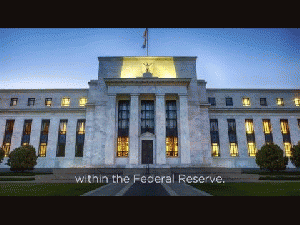From Paul Craig Roberts Website
By Michael Hudson and Paul Craig Roberts*

What the Federal Reserve Rate Hike Means for the Economy
(Image by The Heritage Foundation, Channel: HeritageFoundation) Details DMCA
Even before the Covid-19 crisis had slashed stock prices nearly in half since it erupted in January, financial markets were in an inherently unstable condition. Years of quantitative easing had loaded so much money into stock and bond prices that stock price/earnings multiples and bond prices were far too high by any normal and reasonable historical standards. Risk premiums have disappeared, with only a few basis points separating U.S. Treasury bills and corporate bonds.
The Fed's Quantitative Easing since 2008, plus large companies using their earnings for stock buybacks drove the prices of financial assets into a realm of unreality. The result was that markets already were teetering on the brink of fragility. Any rise of normal interest to more normal conditions, or any external shock, was bound to crash the artificial values at which financial markets were priced. The Fed's policy was to perpetuate this situation for as long as possible by pumping in yet more credit. But at near-zero interest rates, there was little that could be done.
A close parallel to this situation was the state of Third World debt in the mid-1980s. Mexico's announcement that it could not meet its foreign debt service was the shock that brought ugly financial reality into conflict with the assumption that somehow any government debt could be paid even debts denominated in a foreign currency. (Mexico and other countries had denominated their bonds in dollars in order to obtain lower interest rates than bonds denominated in their own currencies would have to pay. The assumption was that export earnings would provide hard currencies with which to redeem the bonds.)
The international financial system was rescued by the issue of Brady bonds "good" new bonds for old "bad" ones. The capital value of these bonds was still far below the original debt, but they had the virtue of setting realistic levels by bringing the debt balance more in line with the actual ability of debtor countries to earn the dollars or other hard currencies needed to service bonds denominated in foreign currencies, mainly the US dollar.
The current crisis requires a similar write-down and recognition that fictitious price levels must give way to reality at some point. In fact, we have reached the end of an illusion -- the illusion that bond (and stock) prices could be sustained indefinitely simply by financial engineering, without an economic base capable of producing enough surplus revenue to justify existing bond and stock prices.
So attractive were the former unrealistic bond and stock levels that the markets are still in the "denial phase" hoping that the Coronavirus bailout may be used as an opportunity for yet further infusion of money into the financial markets. But that merely postpones the inevitable adjustment to bring financial asset prices back in line with real economic capabilities.
There certainly is a financial panic, and prices are not necessarily more realistic in a panic than they were in the bubble leading up to it. The question is, what is a sustainable asset-price level? What needs to be supported is a realistic value of stocks and bonds. Bad debts should be taken off the books, not supported in an attempt to recover the unrealistic pre-virus levels.
A successful way of coping with overpriced bonds and other debts:
Our situation is similar to Third World debt in the early 1980s after Mexico triggered the Latin American debt bomb by explaining that it did not have the money to service its foreign bonds. Prices for Third World bonds plummeted as investors calculated the dollar-earning power of countries that had to export goods and services (or sell off their assets) to pay their foreign-currency debts. But their export proceeds simply could not cover the debt service that was owed.
The Sovereign Debt market was trading at such low prices that these foreign government bonds had become illiquid. Unable to obtain further credit, countries confronted by this financial state of affairs were threatened with political instability.
The Federal Reserve's long Quantitative Easing and support of the financial markets has provided the appearance of stability. This artificial life support has been viewed as saving banks and large companies, pension funds and state and local finance from insolvency. But in doing this the Fed has been fighting what looks like a losing battle against reality. The Fed has been supporting illusory values that cannot be sustained.
The reality is that large swaths of the post 2008 corporate bond market boom have seen a proliferation of corporate bonds that cannot be paid. The fracking industry is only the most visible example. Airlines, entertainment, hotels and retail companies are facing losses that threaten their solvency.
(Note: You can view every article as one long page if you sign up as an Advocate Member, or higher).





